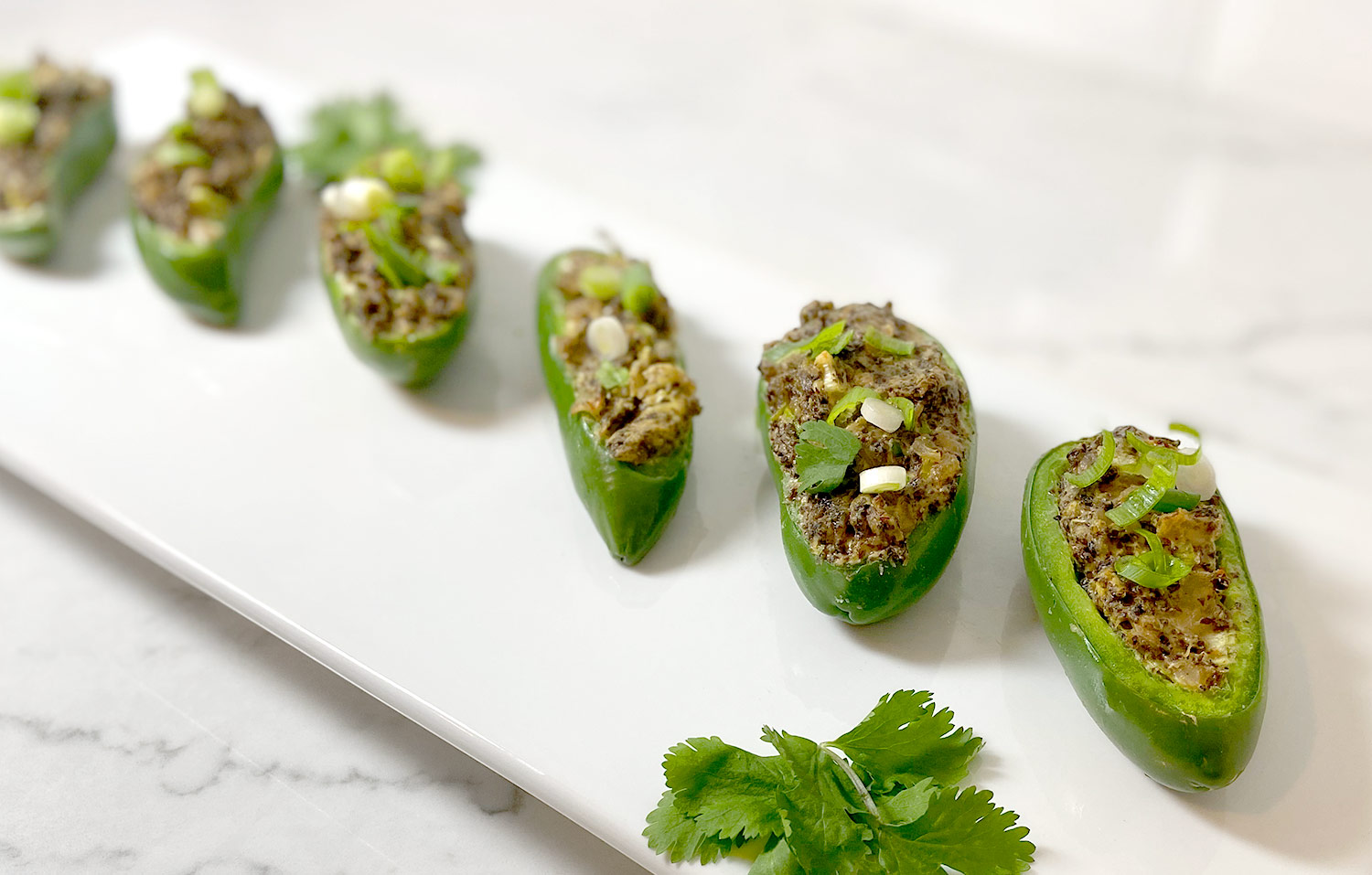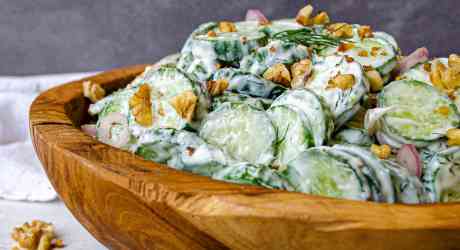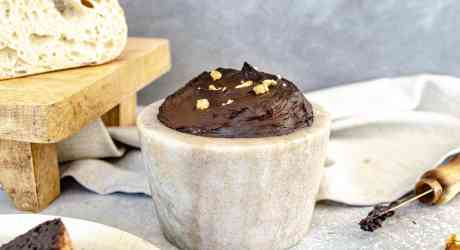Jalapeño Poppers

Whether it be an upcoming family get-together, a potluck for work or a party with friends, how many of you are kept up at night with the dreaded thought of “what can I make?” I can tell you, you are not alone. This is a common struggle with many of our clients, especially around the holidays. But no need to worry any longer, and get ready to impress your family, friends and co-workers with these mood-boosting jalapeño poppers! These crowd-pleasing snacks are the perfect balance of fiery heat and soothing creaminess.
Capsaicin is the compound in jalapeño peppers that is responsible for the hot feeling in our mouth when we take a bite. Capsaicin binds to specific pain receptors on our nerve cells called TRPV1. In response, our body releases endorphins to reduce our perception of pain.
But another cool thing happens when endorphins are released. Endorphins increase the activity of dopamine neurons – the neurotransmitter system I spent my Master’s degree studying. Some people refer to dopamine as our motivating molecule because we know that it is released when something positive happens to us and it helps to reinforce this positive behaviour (and make us want to keep engaging in it). Also, dopamine is one member of our “happiness quartet,” which includes serotonin, dopamine, endorphins and oxytocin. So not only do these poppers taste good, but everyone at the party will be feeling happy and motivated too!
We made sure to keep our friends with food sensitivities in mind. Many people are sensitive or intolerant to cow dairy. So we’ve used goat cheese for the creaminess in this recipe. Goat dairy is much lower in casein (the common allergenic dairy protein found in cow’s milk) and lactose (the common allergenic milk sugar also found in cow’s milk). Goat (or sheep) dairy is overall less allergenic and less inflammatory than cow dairy. Most people who react to cow dairy DO NOT react to goat dairy or they can tolerate it in a "rotational diet" (i.e. once every 4 days).
These poppers are sure to be a hit at your next party or potluck. They are so delicious, nobody will even know they are snacking on brain-healthy fare.
- 12 jalapeños sliced in half, lengthwise, seeds removed
- 1 cup cremini mushrooms, chopped
- 3/4 cup yellow onion, diced
- 1/4 cup green onion, chopped
- 1/4 cup fresh cilantro, chopped*
- 2 cloves garlic, minced
- 1 tsp cumin
- 1 cup grass-fed goat cheese
- 2 Tbsp nutritional yeast
- 1 Tbsp olive oil
- Preheat oven to 425F.
- Place jalapeños facing-up, on a baking tray and lightly brush the jalapeños with olive oil.
- In a pan over medium heat, add the mushrooms and garlic, cook until fragrant and until the water has been released from the mushrooms. Add the onion and cumin and continue to cook until the onions have started to brown- about five minutes. Set aside.
- Mash together the goat cheese, nutritional yeast, cilantro and green onion.
- Stuff the jalapeños with the mixture. You will have leftover filling, but this can be served warm with tortilla chips. Bake the stuffed jalapeños in the oven for 15-18 minutes. You can broil on the top rack for a minute or two for a more intense colour.** If bringing these for a potluck, bake upon arrival if possible.
*For those who think cilantro tastes like soap, a great substitute for this could be parsley.
**We highly doubt there will be any leftovers, they can be stored in the fridge for three days and reheated at 350F (although, they are much better when served fresh).

Cumin:
- Cumin’s powerful antioxidant properties might help curb damage to all cells in our body, as everything from pollution to stress can create oxidative stress.
- For those curious types (or future NeuroTritionists), some new evidence has emerged on the mechanics of cumin’s anti-inflammatory effects in the brain.
Jalapeño Peppers:
- Jalapeños are rich in vitamins A and C – both of which are antioxidants and are known to reduce inflammation in the brain and body.
- Not only is capsaicin mood-boosting, research is suggesting it has anti-inflammatory effects.
Mushrooms:
- These beauties have a special fibre in them, called beta-glucans, which helps improve blood sugar balance, which is so key to a healthy, happy mood.
- They’re also a good source of vitamin C, B’s and brain minerals like selenium.
Olive Oil:
- Packed with nutrients and monounsaturated healthy fats, olive oil is a powerful brain supporter, rich in antioxidants that battle brain inflammation.
- It is chock full of B vitamins, which may help protect against Alzheimer’s Disease. It also contains B vitamins, which may act as a protective factor against degenerative diseases like Alzheimer’s Disease.
- It boosts serotonin to help stabilize mood and ward off depression. Olive oil does it all!
Cilantro:
- Cilantro provides vitamin A, which protects our cell membranes against damage and offers protection against diseases like Alzheimer’s and Parkinson’s.
- It may help reduce levels of the “lousy” cholesterol LDL in the blood.
- References
-
- Thippeswamy, N. B., & Naidu, K. A. (2005). Antioxidant potency of cumin varieties—cumin, black cumin and bitter cumin—on antioxidant systems. European food research and technology, 220(5-6), 472-476.
- Wei, J., Zhang, X., Bi, Y., Miao, R., Zhang, Z., & Su, H. (2015). Anti-Inflammatory Effects of Cumin Essential Oil by Blocking JNK, ERK, and NF-κB Signaling Pathways in LPS-Stimulated RAW 264.7 Cells. Evidence-Based Complementary and Alternative Medicine, 2015, 1-8.
- Bashir, K., & Choi, J. S. (2017). Clinical and Physiological Perspectives of β-Glucans: The Past, Present, and Future. International journal of molecular sciences, 18(9), 1906.
- Conner, T. S., Richardson, A. C., & Miller, J. C. (2015). Optimal serum selenium concentrations are associated with lower depressive symptoms and negative mood among young adults. The Journal of nutrition, 145(1), 59-65.
- Jolayemi, A. T., & Ojewole, J. A. (2013). Comparative anti-inflammatory properties of Capsaicin and ethyl-aAcetate extract of Capsicum frutescens linn [Solanaceae] in rats. African health sciences, 13(2), 357–361.
- Sprouse-Blum, A. S., Smith, G., Sugai, D., & Parsa, F. D. (2010). Understanding endorphins and their importance in pain management. Hawaii medical journal, 69(3), 70–71.
- Abuznait, A., Qosa, H., Busnena, B., El Sayed, K., & Kaddoum, A. (2013). Olive-Oil-Derived Oleocanthal Enhances β-Amyloid Clearance as a Potential Neuroprotective Mechanism against Alzheimer’s Disease: In Vitro and in Vivo Studies. ACS Chemical Neuroscience, 4(6), 973-982.










